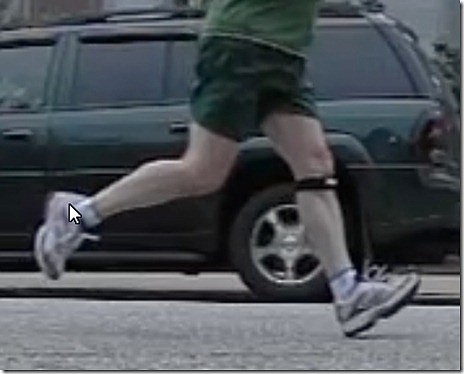 Facebook
Facebook
 X
X
 Instagram
Instagram
 TikTok
TikTok
 Youtube
Youtube

Here we go, I’m about to cure plantar fasciitis. Well, at least help prevent it.
There is no agreement as to what causes plantar fasciitis but the only way to fix it is rest. If a runner has the injury it means a two to three month hiatus from running. That’s not as easy as it sounds. Antonio Gates suffered from his plantar fasciitis for nine months.

The problem with the injury is that it is on the bottom of the foot and it can be aggravated any time the feet are being used. This is the definition of a nagging injury.
How about prevention? There are two ways to help prevent most running injuries. One is addressing gait issues and the other is physical therapy.
Done and done. The end.
Okay, okay. We’ll talk again about gait issues.
The way our feet interact with the ground is crucial to having a long and healthy running life. That’s it. How our feet touch the ground is everything--it’s HUGE. How many recreational runners consider their gait? Based on running injury numbers it’s less than half.
In fact, one study discovered an 89% rearfoot strike rate in middle-of-the-pack runners.
So what? Other studies observe that runners who strike the ground with the rear of their foot are twice as likely to have injuries.
That study is based on competitive runners who are already in shape. Consider the potential for injury in a rearfoot strike when the runner is trying to lose weight and get into shape.
Running shoes enable us to strike with our heels but our bodies have evolved for over 2 million years to be barefoot. Let’s say shoes have been around for 20,000 years; that is to say, since way before recorded history.
20,000 years is 1% of 2 million. 99% of our development has involved our feet interacting with the ground in and of themselves.
Heel striking or rearfoot striking negates the shock absorbing joints of the leg. Our joints bend and flex together to absorb impact.
With a heel strike the foot is way out in front of the body and the joints are locked out. Over time this begins to damage the joints and stress the hips.
Wherever the weak link is, that’s where the injury will show up. It could be the ankle, knee, or hip. It could also result in the overuse of small muscles such as the soleus which leads to shin splints.
Next time we’ll look a few easy adjustments to improve the way our feet interact with the ground.


Here we go, I’m about to cure plantar fasciitis. Well, at least help prevent it.
There is no agreement as to what causes plantar fasciitis but the only way to fix it is rest. If a runner has the injury it means a two to three month hiatus from running. That’s not as easy as it sounds. Antonio Gates suffered from his plantar fasciitis for nine months.

The problem with the injury is that it is on the bottom of the foot and it can be aggravated any time the feet are being used. This is the definition of a nagging injury.
How about prevention? There are two ways to help prevent most running injuries. One is addressing gait issues and the other is physical therapy.
Done and done. The end.
Okay, okay. We’ll talk again about gait issues.
The way our feet interact with the ground is crucial to having a long and healthy running life. That’s it. How our feet touch the ground is everything--it’s HUGE. How many recreational runners consider their gait? Based on running injury numbers it’s less than half.
In fact, one study discovered an 89% rearfoot strike rate in middle-of-the-pack runners.
So what? Other studies observe that runners who strike the ground with the rear of their foot are twice as likely to have injuries.
That study is based on competitive runners who are already in shape. Consider the potential for injury in a rearfoot strike when the runner is trying to lose weight and get into shape.
Running shoes enable us to strike with our heels but our bodies have evolved for over 2 million years to be barefoot. Let’s say shoes have been around for 20,000 years; that is to say, since way before recorded history.
20,000 years is 1% of 2 million. 99% of our development has involved our feet interacting with the ground in and of themselves.
Heel striking or rearfoot striking negates the shock absorbing joints of the leg. Our joints bend and flex together to absorb impact.
With a heel strike the foot is way out in front of the body and the joints are locked out. Over time this begins to damage the joints and stress the hips.
Wherever the weak link is, that’s where the injury will show up. It could be the ankle, knee, or hip. It could also result in the overuse of small muscles such as the soleus which leads to shin splints.
Next time we’ll look a few easy adjustments to improve the way our feet interact with the ground.
Comments